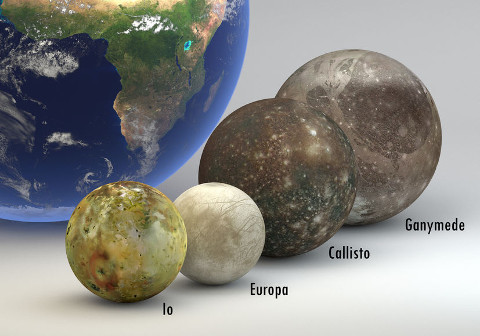That’s no Moon…
Pic of the Week: 29 October 2018

Jupiter’s four largest (“Galilean”) moons, with the Earth for comparison.
As the nickname suggests, these moons were discovered in 1610 by famous astronomer Galileo Galilei and were the first sub-planetary bodies (other than the Moon) to be discovered from Earth. Each of them is of particular interest, for a variety of reasons:
- Ganymede is the largest satellite in the Solar System. It’s even bigger than Mercury, although considerably less dense and therefore has only about half the mass.
- Callisto is slightly smaller than Ganymede but is still the Solar System’s third largest moon (Saturn’s Titan comes in between). It’s one of the most heavily cratered satellites and has one, named Valhalla, that’s about 3,000 km wide!
- Io is next – although it was actually the first moon Galileo saw. It has over 400 active volcanoes, making it the most geologically active object in the Solar System. Some of its mountains are taller than Everest.
- Europa is the fourth largest, and is just slightly smaller than the Moon. It’s of particular interest to scientists because it appears likely that its thick frozen crust may cover an ocean of liquid water and could therefore conceivably harbour life as we know it.
Don’t worry about the title – none of these natural satellites is believed to be a masquerading Death Star.

Leave a Reply